The flag of Saint Kitts and Nevis carries with it not just colors and designs but the very essence of the nation it represents. It’s a visual narrative, telling stories that words often cannot capture, offering a glimpse into the collective soul of its people.
As we delve deeper into the significance of this flag, we’ll uncover the layers of meaning and the emotions it evokes in its citizens and its place in the global community.
Saint Kitts and Nevis Flag

The flag of Saint Kitts and Nevis boasts a distinct layout characterized by its diagonal division and the inclusion of two stars within a prominent stripe. While aesthetically pleasing, this design carries a depth of universally recognized symbols that reflect the country’s legacy, values, and aspirations.
Saint Kitts and Nevis Flag: Color Palette
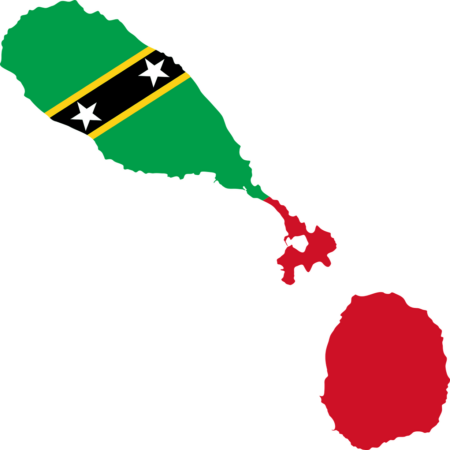
Saint Kitts and Nevis Flag Emoji: 🇰🇳
The flag of Saint Kitts and Nevis showcases a striking color palette that holds deep significance. This palette elegantly captures the nation’s essence, laying the foundation for a detailed exploration of each hue.
Meaning of Each Color
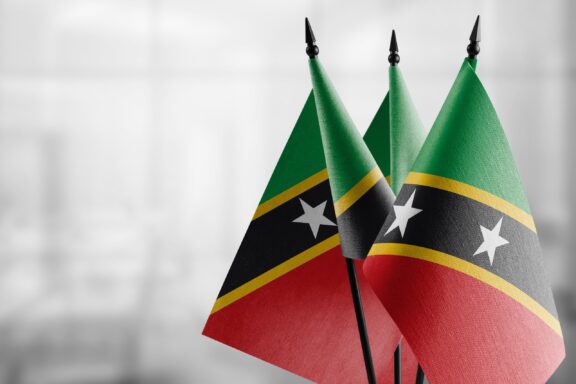
Green
Historically, green often symbolizes a land’s lush vegetation and natural beauty. For Saint Kitts and Nevis, it encapsulates the fertile soil and the verdant landscapes that dominate the islands.
Culturally, green is a reminder of the agricultural roots, with sugar cane being a significant crop in its history.
Red
Red is a potent color, often associated with the blood shed by those who fought for rights and independence.
In the context of Saint Kitts and Nevis, it symbolizes the sacrifices made by its people in their quest for freedom and autonomy. The presence of red is a tribute to the resilience and courage of past generations.
Yellow
This radiant hue is emblematic of the abundant sunshine that graces the islands. Historically, sunshine provided warmth and played a crucial role in the growth of crops, boosting agriculture.
Moreover, yellow is a beacon of optimism, suggesting a bright future for the country.
Black
Black signifies the rich African heritage of the island’s inhabitants. Saint Kitts and Nevis, like many Caribbean nations, has deep-rooted ties to Africa, primarily due to the transatlantic slave trade.
The color is a homage to the ancestors and the profound influence of African culture on their identity.
White
White denotes purity, hope, and liberty, especially in the form of the stars and outlines on the flag. It acts as a contrast to the other colors, emphasizing peace and unity.
The two stars in particular signify hope for the future and the unity between the two main islands.
Saint Kitts and Nevis Coat of Arms
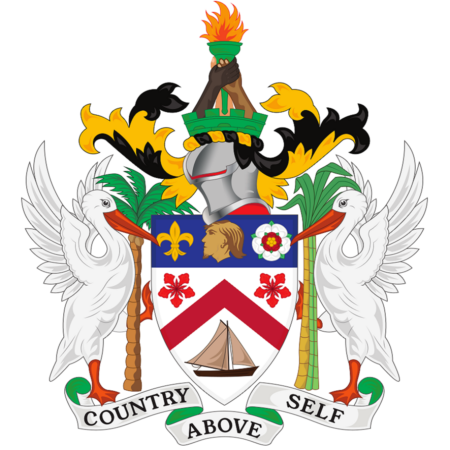
The coat of arms of Saint Kitts and Nevis is a rich tapestry of symbols that provide insight into the nation’s history, culture, and natural attributes.
At its center is a shield adorned with motifs representing the country’s landscape and past. Flanking the shield are two supporters, each with their historical significance.
Above, a distinguished helm and mantling are topped by a figure paying homage to the islands’ indigenous peoples. The entirety rests upon a banner bearing its motto, emphasizing its core values.
Historical Evolution and the Meaning Behind Changes
The current flag of Saint Kitts and Nevis was adopted upon the country’s independence in 1983. Before this, Saint Kitts and Nevis did not have a unique flag, as they were under British colonial rule.
To understand the evolution of the flag’s symbolism and design, we can look at its history in the context of colonial flags and the current national flag:
Like many other British colonies during the colonial period, the islands flew the British Blue Ensign, which was blue with the Union Jack in the top left corner. The badge specific to Saint Kitts and Nevis would have been placed on the right side of the flag.
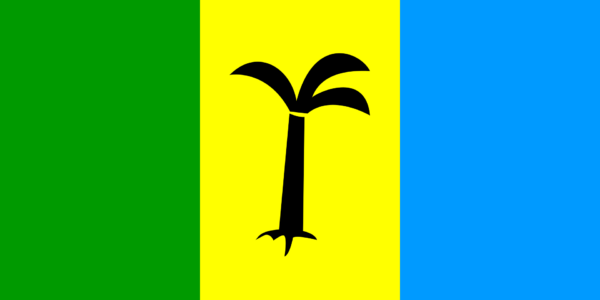
This badge often featured elements symbolizing the colony’s primary industry or identity, such as a depiction of a ship or elements related to sugar production, reflecting the islands’ past as sugar-producing colonies.
As Saint Kitts and Nevis moved towards independence, there was a desire to create a flag representing all facets of the nation’s identity and aspirations. A national competition was held to choose the new flag’s design, which led to the current design being chosen.
Overall Symbolic Meaning of the Flag
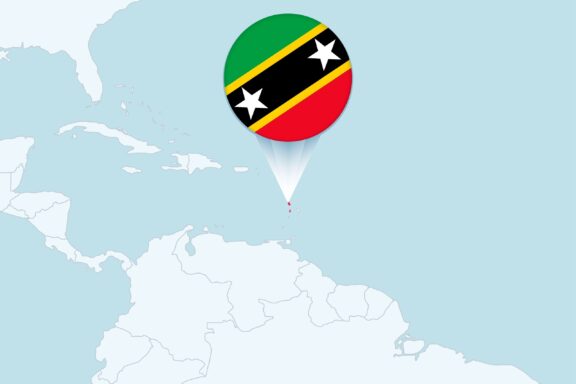
Saint Kitts and Nevis’s flag weaves meaningful symbols together, reflecting diverse facets of the nation. Its design artfully conveys the nation’s history and forward-looking ambitions.
The flag is a tribute to Saint Kitts and Nevis, honoring its rich heritage and embodying hopes for a promising tomorrow.
Similar Flags to Saint Kitts and Nevis
Flags often share design elements that hint at intertwined histories or common themes. Let’s dive into three flags that echo similarities with that of Saint Kitts and Nevis.
Republic of the Congo
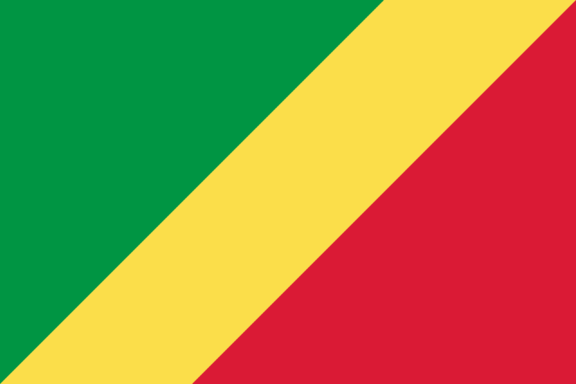
The flag of the Republic of the Congo consists of a diagonal tricolor of green, yellow, and red. The diagonal starts from the lower hoist side, much like the flag of Saint Kitts and Nevis.
The diagonal division in both flags is a unique design choice for national flags. However, the colors have different significances for each country, with the Congo’s colors often linked to Pan-African symbolism.
Continue reading: Republic of the Congo Flag Map and Meaning.
Guyana
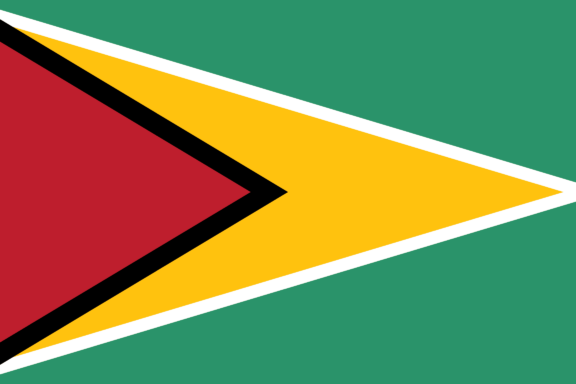
Guyana’s flag, known as “The Golden Arrowhead,” features a green field with a red isosceles triangle in the hoist, superimposed by a narrower white fimbriation, which is further overlaid by a golden triangle. The fly side of the flag has a black fimbriation with a narrower white one on its outside.
The striking design features a unique use of triangles and fimbriations, making it reminiscent of Saint Kitts and Nevis’s flag with its distinctive layout and use of colors. Both flags avoid the standard horizontal and vertical stripe designs, opting for more dynamic shapes.
Continue reading: Guyana Flag Map and Meaning.
Ghana
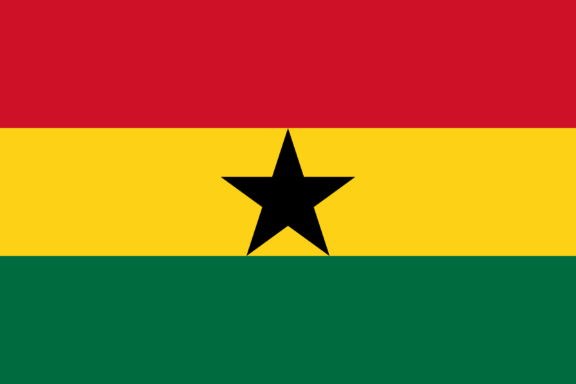
Ghana’s flag consists of horizontal stripes of red, yellow, and green, with a black five-pointed star in the center of the yellow stripe.
While the layout differs from Saint Kitts and Nevis’s flag, Ghana’s choice of colors — especially the inclusion of a star as a central symbol — can draw parallels.
The colors in Ghana’s flag have Pan-African roots, with the red, yellow, and green often representing the African freedom movement. The black star in the center symbolizes freedom and African independence.
Continue reading: Ghana Map and Meaning.
São Tomé and Príncipe
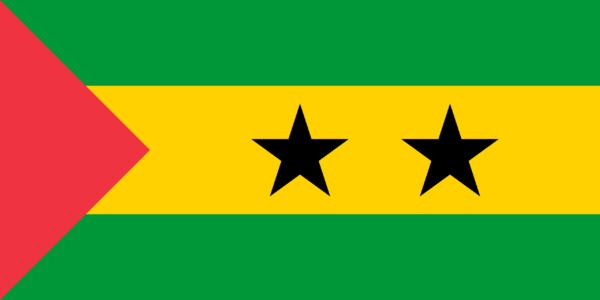
The flag of São Tomé and Príncipe comprises three horizontal bands of green, yellow, and green—the yellow band houses two black five-pointed stars representing the country’s two main islands. A red triangle, based on the hoist, extends into the flag.
While horizontally striped, incorporating stars and using a triangle at the hoist side might draw parallels with the design elements of Saint Kitts and Nevis’s flag.
Both flags utilize stars to signify major islands or parts of the country and incorporate a vibrant mix of colors to symbolize various national themes.
Continue reading: Sao Tome and Principe Flag Map and Meaning.
Conclusion
Amidst the diverse global flags, Saint Kitts and Nevis’s banner shares intriguing design elements with our highlighted nations. These parallels speak to design choices and hint at overlapping stories and shared cultural motifs that enrich our understanding of these nations’ identities.
Image Sources and Copyright Information
- Flags of Saint Kitts and Nevis: © hisBUTENKOV ALEKSEI/Shutterstock